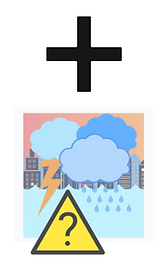Striking the Right Degree of Uncertainty for Communicating Global Warming Impacts
By Kirsten Giesbrecht
Title: Acknowledging uncertainty impacts public acceptance of climate scientists’ predictions
Author(s) and Year: Lauren C. Howe, Bo MacInnis, Jon A. Krosnick, Ezra M. Markowitz & Robert Socolow, 2019
Journal: Nature Climate Change

Of the three scientists pictured here in Figure 1, who do you find the most trustworthy? Howe and her coauthors wanted to pinpoint the best way to present uncertainty when communicating about projected global warming impacts. These researchers also wanted to know if message acceptance depended on how trustworthy the scientist seemed to the respondents. Does appearing more trustworthy make it more likely that an audience will accept the science communicator’s message?
Striking a balance between sounding overconfident and sounding inept is a difficult line to toe when communicating findings on global warming. On one hand, sounding too uncertain and unconfident may undermine the science communicator’s credibility and expertise. On the other hand, overconfidence in predicting future outcomes can make a science communicator appear less trustworthy to the public since the general public acknowledges that it’s impossible to perfectly predict the future. When experts express some degree of uncertainty in fields relating to forecasting, from finance to weather, their perceived trustworthiness may actually increase.
Science communicators can choose to express a variety of degrees of uncertainty when describing the predicted impacts of global warming. Sometimes science communicators will provide predicted and worst-case scenarios. Previous studies have found that providing a worst-case scenario can jolt the audience into action, but providing the worst-case scenario also risks the audience feeling as though they are being manipulated, leading them to lose trust in the scientist, and reject the message. Conversely, providing both a best case and worst case scenario might cause information overload and confusion in the audience. Previous studies also show that the audience might also jump to the best-case scenario when provided with fully bounded cases.
Providing both the most likely future outcome as well as the best- and worst-case scenarios is an especially effective option. This option involves acknowledging study limitations, which makes people trust the scientist more and accept their message.
The Study
In 2013, Howe et al. surveyed over 1,000 Americans of various ages, ethnicities, races, income levels, genders, political views, and education levels. The survey presented the respondents with six different messages about forecasted global sea-level rise and follow-up questions:
| Message Symbol | Message Uncertainty | Description | Example |
 | (1) No uncertainty | An exact value for predicted global sea-level rise | “Scientists believe that, during the next 100 years, global warming will cause the surface of the oceans around the world to rise about 4 feet.” |
 | (2) Upper Bounded Uncertainty | An exact value for predicted global sea-level rise and a worst-case scenario | “Scientists believe … oceans around the world to rise about 4 feet. However, sea level could rise as much as 7 feet.” |
 | (3) Fully Bounded Uncertainty | An exact value for predicted global sea-level rise and a range of worst and best-case scenarios | “Scientists believe … oceans around the world to rise about 4 feet. However, sea level could rise as little as 1 foot or it could rise by as much as 7 feet.” |
 | (4 – 6) Irreducible Uncertainty | A Respective repeat of the first three messages plus an additional statement describing how higher sea levels will contribute to more severe, less predictable, weather patterns. | Messages 1-3 (respectively) + “Scientists believe that global warming will cause these storms to be more intense in the future. During these storms, oceans will surge as high as 20 feet along hundreds of miles of coastline and will suddenly flood cities with large amounts of water…” |
The Results

Figure 2 describes the resulting message acceptances of the six tested messages. If participants read statements providing either an exact estimated sea-level rise value or a single bound on the uncertainty, including the irreducibility statement had no impact on the respondents’ acceptance of the message and trust in the scientists.
Respondents who read message 3 of a fully bounded uncertainty with no irreducibility uncertainty statement had the highest message acceptance and trust in the scientist of all the six groups. The researchers found these fully bounded uncertainty statements increased the trust in the scientists which in turn increased message acceptance. This increased message acceptance effect was consistent, regardless of a respondent’s education level or previously held beliefs regarding global warming.
However, trust and message acceptance decreased when the irreducibility statement of uncertainty was included with the fully bounded uncertainty statement. Respondents were less likely to accept the message and had less trust in the scientist, compared to the first two messages, with either no or partially bounded uncertainty. The researchers suppose this reversal might occur since the irreducibility emphasizes the worst-case scenario.
The Impact
The study has some limitations; for instance, the researchers didn’t examine how including the likelihood of different outcomes influenced message acceptance. However, the researchers concluded that sharing the full bounds of uncertainty, but not the inevitable uncertainty (Message 3), produced the highest message acceptance and trust from audiences.
For a science communicator who shares forecasts and climate science, these findings indicate that acknowledging some uncertainty increases the communicator’s trustworthiness to the audience which leads to increased message acceptance. However, overwhelming the audience with too much uncertainty can decrease trust in the science communicator and message acceptance.
Edited by Carolyn Decker and Niveen AbiGhannam
Cover image credit: Figures generated through Biorender. Cover image modified images by CaelHendry and Schäferle via Pixabay, CC by CC0

